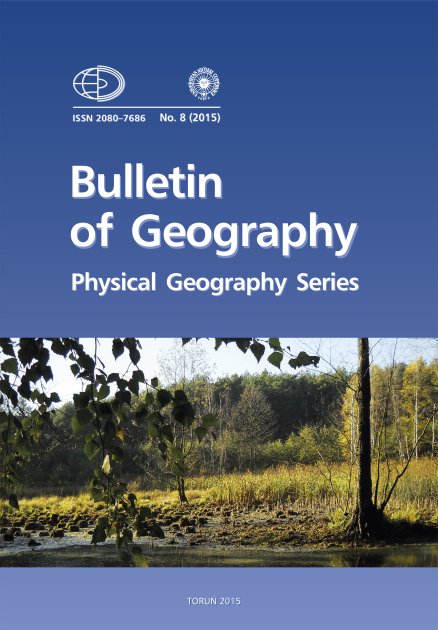The morphology of the Luciąża River valley floor in the vicinity of the Rozprza medieval ring-fort in light of geophysical survey
DOI:
https://doi.org/10.2478/7033Keywords
valley floor, geological mapping, geophysical surveying, Middle Ages, central PolandAbstract
Multidisciplinary research (including magnetic survey, earth resistance survey, geological mapping, detailed archaeological surface survey and geochemical prospection) was undertaken on an area of about 0.7–9.0 hectares (depending on the method) in the close surroundings of the medieval ring-fort relicts in central Poland. The geophysical studies of the vicinity of the Rozprza ring-fort were part of a multi-method complementary non-destructive archaeological survey. The ring-fort is situated in the Luciąża River (Vistula River basin) valley floor and the flood plain morphology is very important for the reconstruction of palaeoenvironmental conditions of settlement location. Results of aerial photographs and geophysical prospection allowed the discovery of traces of sub-fossil palaeomeanders of different sizes as well as relicts of archaeological features (system of ramparts and moats). It was possible due to the application of high resolution archaeo-geophysical surveys. Both natural structures and also anthropogenic features registered with geophysics have been verified by geological sounding. The surface geology structure of the close vicinity of the ring-fort has been recognised in detail and selected organic deposits of palaeochannel fills and overbank covers have been 14C dated. The Rozprza ring-fort was situated in a defensive location on the surface of a sandy terrace remnant in the central part of a (partly) swampy valley floor. The accumulation of recorded fills of palaeochannels and moats covers the whole Holocene, as documented by 14C data. It gives the possibility for future detailed palaeoenvironmental studies. The results of geophysical studies, due to their known precise location, allow the effective planning of further research activities, both archaeological and palaeoenvironmentalReferences
BRONK RAMSEY C., 2009, Bayesian analysis of radiocarbon
dates. Radiocarbon, 51: 337–360.
CHMIELOWSKA A., 1966, Sprawozdanie z badań
wczesnośredniowiecznego kompleksu osadniczego
w Rozprzy. Prace i Materiały Muzeum Archeologicznego
i Etnograficznego w Łodzi, Seria Archeologiczna,
: 249–265.
CHMIELOWSKA A., 1982, Rozprza we wczesnym i późnym
średniowieczu. Prace i Materiały Muzeum Archeologicznego
i Etnograficznego w Łodzi, Seria
Archeologiczna, 29: 159–206.
GOŹDZIK J., 1982, Środowisko przyrodnicze osadnictwa
średniowiecznego okolic Rozprzy. Prace i Materiały
Muzeum Archeologicznego i Etnograficznego
w Łodzi. Seria Archeologiczna, 29: 138–151.
DAVID A., LINFORD N., LINFORD P., 2008, Geophysical
Survey in Archaeological Field Evaluation (2nd
edn.). English Heritage, Swindon.
FORYSIAK J., 2005, Rozwój doliny Warty między Burzeninem
i Dobrowem po zlodowaceniu warty. Acta Geo-
graphica Lodziensia, 90.
KALICKI T., 2006, Zapis zmian klimatu oraz działalności
człowieka i ich rola w holoceńskiej ewolucji dolin
środkowoeuropejskich. Prace Geograficzne IGiPZ
PAN, 204.
KRUPA J., 2013, Natural and anthropogenic factors influenced
Czarna Nida river valley during the Late Glacial
and Holocene. Folia Quaternaria, 81: 5–174.
KITTEL P., 2011 (2013), Slope and river inorganic deposits
as indicators of marked human impact, in the
light of research in the Ner River basin (central Poland).
Archaeologia Polona, 49: 71–86.
KITTEL P., 2012, Budowa i ewolucja doliny Neru w rejonie
stanowiska Lutomiersk-Koziówki w świetle badań
geoarcheologicznych. Acta Geographica Lodziensia,
: 113–133.
KONDRACKI J., 1998, Geografia regionalna Polski.
PWN, Warszawa.
REIMER P.J., BARD E., BAYLISS A., BECK J.W., BLACKWELL
P.G., BRONK RAMSEY C., GROOTES P.M.,
GUILDERSON T.P., HAFLIDASON H., HAJDAS I.,
HATT C., HEATON T.J., HOFFMANN D.L., HOGG
A.G., HUGHEN K.A., KAISER K.F., KROMER B.,
MANNING S.W., NIU M., REIMER R.W., RICHARDS
D.A., SCOTT E.M., SOUTHON J.R., STAFF R.A.,
TURNEY C.S.M. and van der PLICHT J., 2013, IntCal13
and Marine13 Radiocarbon Age Calibration
Curves 0-50,000 Years cal BP. Radiocarbon, 55: 1869–
–1887.
SIKORA J., 2007, Polska Centralna we wczesnym średniowieczu
w świetle badań archeologicznych i osadniczych.
Slavia Antiqua, 48: 121–159.
SIKORA J., 2009, Ziemie Centralnej Polski we wczesnym
średniowieczu. Studium archeologiczno-osadnicze.
Seria: Monografie Instytutu Archeologii Uniwersytetu
Łódzkiego, vol. VII, Instytut Archeologii Uniwersytetu
Łódzkiego, Łódź.
STARKEL L., 1983, The reflection of hydrologic changes
in the fluvial environment of the temperate
zone during the last 15000 years. [in:] Gregory K.J.
(ed.), Background to Palaeohydrology, Chichester:
–237.
STARKEL L., 2002, Younger Dryas–Preboreal transition
documented in the fluvial environment of Polish rivers.
Global and Planetary Change, 35: 157–167.
STARKEL L., GĘBICA P., 1995, Evolution of river
valleys in southern Poland during the Pleistocene-
Holocene transition. Biuletyn Peryglacjalny,
: 177–190.
STARKEL L., MICHCZYŃSKA J. D., KRĄPIEC M.,
MARGIELEWSKI W., NALEPKA D., PAZDUR A.,
, Progress in the Holocene chrono-climatostratigraphy
of Polish territory. Geochronometria, 40:
–21.
TURKOWSKA K., 1990, Main fluvial episodes in the Ner
Valley in the last 22 000 years; a detailed study in Lublinek
near Łódź, Central Poland. Quaternary Studies
in Poland, 9: 85–99.
TURKOWSKA K., 1995, Recognition of valleys evolution
during the Pleistocene–Holocene transition in
non-glaciated region of Polish Lowland. Biuletyn
Peryglacjalny, 34: 209–227.
TURKOWSKA K., 2006, Geomorfologia regionu łódzkiego.
Wydawnictwo Uniwersytetu Łódzkiego, Łódź.
TWARDY J., FORYSIAK J., KITTEL P., 2014, Evolution
of vegetation, relief and geology in Central Poland
under anthropopressure. [in:] Kobojek E., Marszał T.
(eds.), Origin of relief of Central Poland and its anthropogenic
transformation in Łódź University geographical
research. Wydawnictwo Uniwersytetu
Łódzkiego, Łódź: 57–94.
SZUMAŃSKI A., 1983, Paleochannels of large meanders
in the river valley of the Polish Lowland, Quaternary
Studies in Poland, 4: 207–216.
The morphology of the Luciąża River valley floor in the vicinity of the Rozprza medieval ring-fort… P. Kittel et al.
WACHECKA-KOTKOWSKA L., 2004a, Ewolucja doliny
Luciąży – uwarunkowania klimatyczna a lokalne.
Acta Geographica Lodziensia, 86.
WACHECKA-KOTKOWSKA L., 2004b, Zmiany środowiska
doliny dolnej Luciąży w holocenie. Acta Universitatis
Lodziensis, Folia Geographica Physica, 6: 47–70.
Downloads
Published
How to Cite
Issue
Section
Stats
Number of views and downloads: 414
Number of citations: 0



